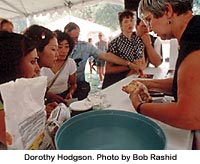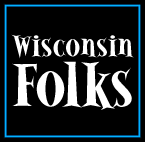|
Home | Search | The Artists | Teaching | Hiring | About This Site | Contact Us |
||||||||||
 Traditions In |
 Pasties
...why miners ate pasties? The first miners in Wisconsin were immigrants from Cornwall, England. In Cornwall, these men had worked as tin miners, an important industry in Cornwall. Cornish wives sent pasties with their husbands for lunch or dinner. The miners wanted something they could eat with their hands and something that would fill them up. They were very hungry by meal time—mining is hard work! The self-enclosed and very hearty pasty was perfect. ...who were “the Knockers?” In Wisconsin, Cornish cooks put their husband’s initials on their pasty to make sure that the right man ate it. As Dorothy used to say, “The wise got wise.” But the miners also used the initials for something else. Miners used their initials to show who had left some food for the Knockers. Knockers were the mischievous ‘little people’ of the mines. Miners believed the Knockers could cause all kinds of bad things to happen. Miners might leave a bit of pasty for them as a gift, to coax the Knockers into bringing good luck. If the miner left the part with his initials, the Knockers would know who to thank. ...how to keep pasties warm? Dorothy’s mom first wrapped the pasty in paper and then wrapped it with cloth. Men who worked in the mines often wore bib overalls, and they would put the wrapped pasty in their front pocket. Body heat would keep the pasty warm until they reached the mines. Many mines had an area where the men could keep their pasty warm until meal time. Listen to Dorothy tell about how the miners used ...about having a pasty for dessert? Pasty cooks sometimes made two pockets within a pasty, one for the “main dish” and a second for “dessert.” The dessert pocket had a fruit filling. ...how pasties became so popular? Lead mining was an important industry in southwest Wisconsin until the 1840s, and zinc mining until the 1970s. Because the Cornish miners brought pasties into the mines, pasties became part of mining culture. Other immigrant groups joined the Cornish in the mines. Those miners wanted pasties too. Their wives started cooking pasties, making the food something that lots of people who lived in the area ate. The pasty became part of the regional culture of southwestern Wisconsin.  Dorothy’s tradition of making pasties didn’t come from her Learn More! Would you like to make a pasty? You can find lots of recipe web links on Resources for Students. If you’re not up for cooking, see if there’s a local pasty shop near you. Stop in and ask them what they think makes an “authentic” pasty.
|
For Educators: |
||||||||
|
“My father used to work in the lead mines. I was very young at the time, but I do remember that he would go off to work in the lead mines. He worked at night, and I’m sure that mother sent pasty with him.” – Dorothy Hodgson |
||||||||||
|
Home | Search | The Artists | Teaching | Hiring | About This Site | Contact Us |
||||||||||

